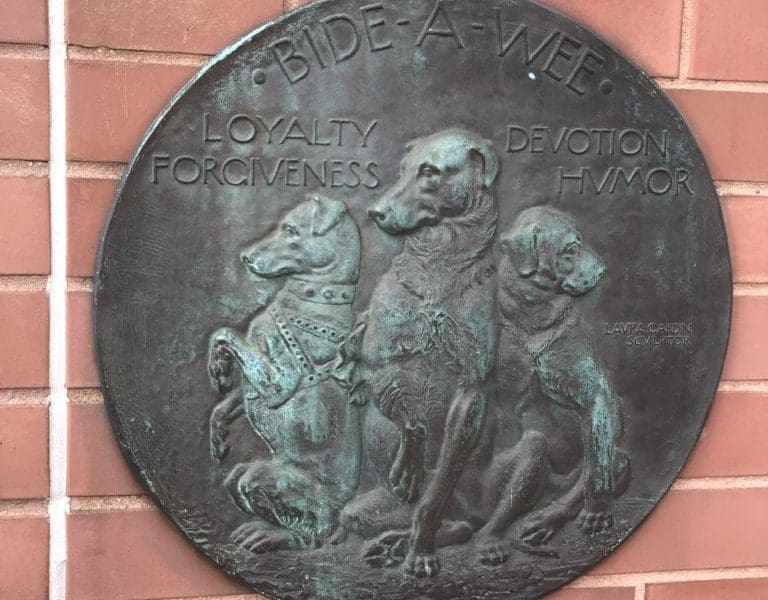Bideawee (New York, NY)
The floors at Bideawee, an animal shelter in Manhattan’s Murray Hill, are sparkling clean when spokesperson Melissa Treuman takes The Canine Review on a tour. It’s a Monday morning in September. Treuman greets volunteers and stops to pet the dogs.
Since its founding in 1903, Bideawee, which is Scottish for “stay awhile,” has expanded out to two Long Island locations, one in Westhampton and another in Wantagh (the latter is not an adoption center, but an entry point for incoming dogs).
The three Bideawee locations share three full-time veterinarians, five full-time veterinary technicians, three full-time veterinary assistants, and one part-time veterinary assistant, according to Colleen Roche, a communications consultant for Bideawee.
Treuman says that when a dog first comes to Bideawee, it is brought to Wantagh, where it is assessed by a veterinarian before proceeding to an adoption center in Manhattan or Westhampton. Ideally, a dog is spayed, neutered, vaccinated and medically treated at the Wantagh location. However, Treuman says, “depending on time and availability of the vets, it’s not always possible. Very often they are already cleared, spayed, neutered, and healthy by the time they get to the location.”
Shelter Life
Once at one of the adoption centers, dogs are cared for by shelter staff and volunteers, as well as on-site veterinarians and trainers. At the Manhattan location, dogs who need further medical or behavioral evaluation are brought to a kennel hospital on the ground floor of the building, where there are two full-time veterinary technicians and two full-time veterinary assistants, among other veterinary staff, according to Ms. Roche.
On the third floor of the Manhattan location, there is a large multipurpose room where adopters can meet and interact with dogs. This room is also used for training classes.
According to Ms. Roche, the shelter’s communications consultant, there are 65 full-time Bideawee employees across the three locations. Bideawee had 700 active volunteers during the last half of 2019.
Jahshaun Julien started volunteering on the weekends at Bideawee in January 2019. “The dogs seem really happy,” he says. On Saturdays, Julien works at the Manhattan location for three hours where he says he assists with walking the dogs, cleaning their cages and water bowls, giving them medication, sometimes eye drops, and providing them with fresh water.
Adoption Process and Policies
At Bideawee, prospective adopters must fill out an application and arrive at the shelter with a leash, collar, harness, all members of their household, and any dogs that they already have.
Interested buyers are set up with a “Bideawee Matchmaker” who pairs them with a dog or dogs.
When Delaney Horsley saw a photo of her black lab mix, Indi, on Bideawee’s website in July of 2019, she told The Canine Review in a telephone interview how she immediately fell in love. Horsley also recalled the details of her adoption experience with Bideawee:
Horsley, who lives in Providence, Rhode Island, told The Canine Review she had been searching online for a dog using Adopt-a-Pet and was having trouble finding the right fit. She noticed her search radius was only at 100 miles and decided to expand to 250 miles. That was how she came across Bideawee, and happened upon Indi, with whom she felt an instant connection. “I can’t describe it, but if I had to pin it down, she looks a lot my previous dog. Big brown eyes, you know.”
The following day, Horsley says she and her boyfriend raced down I-95 to get to Long Island and meet Indi. They arrived at Bideawee’s Westhampton location on July 5, 2019, 45 minutes before closing time. A Bideawee team member took them on a tour of the shelter, Horsley recalls. “It was clean, it was well lit, and the dogs appeared healthy and as happy as they could be in a shelter.” The staff introduced Horsley and her boyfriend to many of the dogs in the shelter to help her find the right fit.
“I found this to be really special, because they were really interested in making sure we got the right dog,” Horsley says. “It wasn’t like they were just trying to move them.” A team member led her and her boyfriend into a large playroom, Horsley recalled, to interact with Indi. As soon as Indi was let off her leash, she bounded over into her [Horsley’s] lap. “I just burst into tears,” says Horsley.
Post-Adoption and Other Services
According to Horsley, Indi came home with up-to-date vaccinations and a guarantee that if Indi were to get sick in her first month at home, Bideawee would cover the cost of treatment. A member of the Bideawee team follows up on all adoptions with a phone call to see how the animal is doing in their new home.
Bideawee offers a wide range of services to pet owners including pet therapy training for dogs, cats, and rabbits.
A unique service the shelter offers is pet cremation and even burial services in the shelter’s two memorial parks.
Finances
Bideawee publishes annual revenues and expenses, as well as assets and liabilities on its website. In the tax year ending September 30, 2018, Bideawee’s total revenue was $11,222,162. This includes $1,354,824 from the adoption centers, animal hospital, pet memorial services, and $5,925,988 in bequests and legacies.
The total annual expenses for that same year were $9,952,229 including $6,934,136 for program services.
In the same tax year, Bideawee had $16,403,721 in mutual funds, received $5,925,988 in bequests in legacies and $1,502,910 in contributions.
The shelter’s most recent, publicly available information on its major donors is in its 2016-2017 Annual Report. That year, the shelter received a donation of over $1,000,000 from the estate of Paul Lelong and a donation between $500,000 and $999,999 from the estate of Myra McKolic. Other top donors include the Jules H. Drucker Living Trust, the estate of Zelma Flohr, and the estate of James A. Golczewski, according to the 2016-2017 report.
Outcomes and Transparency
Ironically, although Bideawee appears to have excellent, well-maintained facilities, happy clients, loyal volunteers, and impressive infrastructure, the Manhattan shelter – which is less than 20 blocks from Rockefeller Center – has a press shop that seems disinclined to let the world know about Bideawee’s good qualities. The shelter’s in-house communications person, Melissa Treuman, declined a series of requests to provide any current or historical data regarding the outcome of dogs entering Bideawee. To date, Bideawee is the only shelter TCR has profiled that has fully declined to provide outcome data.
Leslie Granger – President and CEO
Raymond Cushmore – COO
Dr. Shian Simms – Vice President, Veterinary Medicine
Board
Officers
Joseph L. Sorbera, Jr., Chair
Leslie C.G. Campbell, Vice Chair, Administration
Todd B. Richter, Vice Chair-Strategic Planning
Steven R. Victorin, Treasurer
Pamela Laudenslager, Secretary
Leslie Granger, President and CEO
Directors
Kurt A. Abrams
David H. Best, MD, MBA
Kevin Davis
Patricia Haegele
Lynn Killeen
Robert G. Koen
Keith Manning, DVM
Doug Ray
Patricia Stewart
Thomas W. Young
Emeritus
Lewis H. Berman, DVM
Elizabeth R. Cooke
William A. Dueker Jr.
Warren Eckstein
Ellen C. Grimes
Mary M. Luria, Esq.



